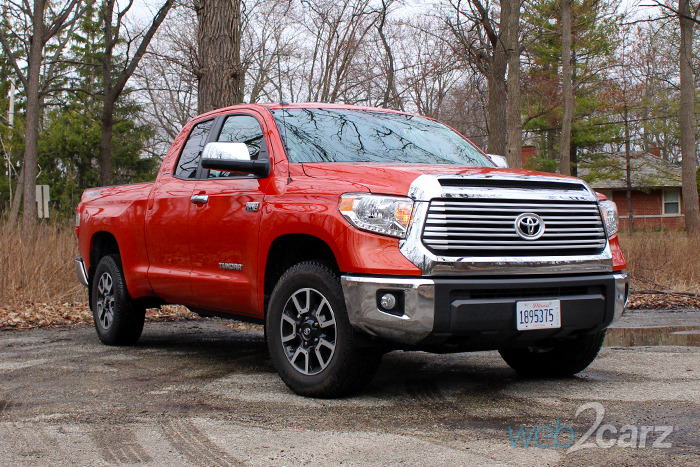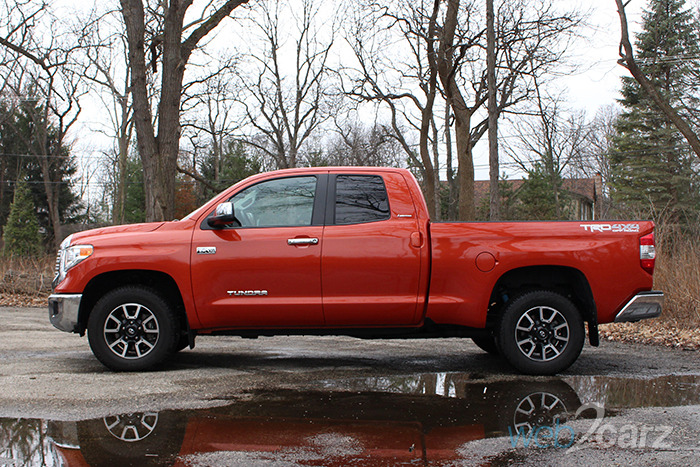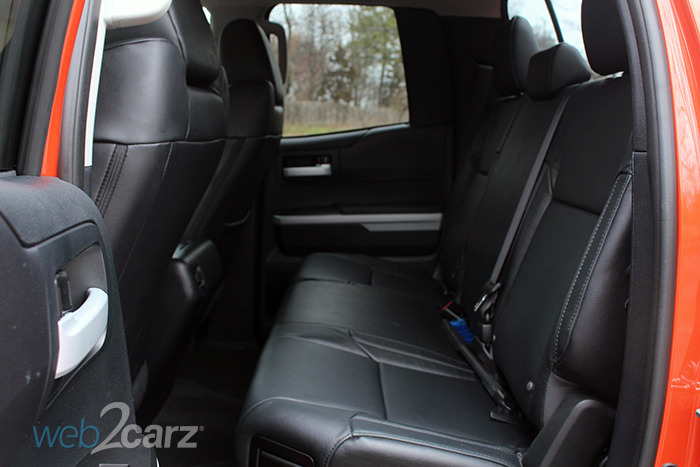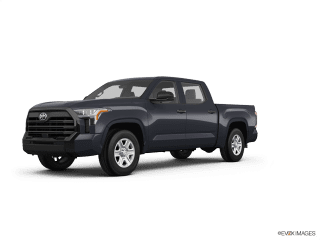















































Wade Thiel, Senior Staff Writer
 | Positives: Smooth over rough pavement and terrain, good visibility all around, faster than expected. |
 | Negatives: Too much exterior chrome, poorly thought out center console, gas hog, light and vague steering. |
 | Bottom Line: The Toyota Tundra Limited with the TRD Off-Road package is an off-road ready pickup that's more than acceptable on road. It's not as hardcore as the TRD Pro version and isn't as street focused as the non-off road versions of the truck. If you're looking for a full sized truck that can fit five people, occasionally tow a trailer, and always be ready to go off road, this is a smart choice. |
| View Our 2017 Toyota Tundra Overview |
Driving Experience
8.1
The Tundra we drove came with the off-road package, and this meant it had a softer ride than we expected. Our tester came with trail-tuned shock absorbers and beefy all-terrain tires. Though the pickup was tuned for off-road trail use, it still managed to be more than competent on the road, by providing a smooth and confidence-inspiring experience on city streets and the highway.
Ride Quality: The suspension does a good job of reducing the impact of bumps and gaps in the road. Overall, the ride was smoother than expected for a body-on-frame pickup.
Acceleration: The 5.7-liter V8 engine propels the truck forward much faster than expected. It can launch the Tundra from a standstill to 60 mph in about six and a half seconds.
Braking: The progressive brakes feel strong and provide good feel. The Tundra stops from 70 mph in about 190 ft. This isn’t as good as the Ford F-150, Chevrolet Silverado, or GMC Sierra 1500, but it’s better than the RAM 1500 and the Nissan Titan.
Steering: The steering is on the lighter side and has poor on-center feel, but this makes maneuvering around tight spaces at low speeds easier than we thought. Keeping it straight on the highway takes a bit of effort, but it’s not exhausting.
Handling: The softer off-road suspension and big tires mean there’s some body roll, but you still feel confident in the curves due to the truck’s ability to cling to the road.
Technology
7.2
The Tundra comes in multiple trim levels and with plenty of packages, which means you can get the Tundra just about however you want it. Our tester came with Toyota’s Entune infotainment system with navigation, an app suite, and a 7-inch touchscreen. Overall, it’s a high-quality system, but it isn’t perfect, due to some ergonomic issues and dull graphics.
Infotainment System: The 7-inch touchscreen works well, is clear, and operates smoothly, but the Entune interface is somewhat dull and dated looking. Toyota could improve its tech, by livening it up with more colors and better graphics.
Controls: The infotainment system’s controls are simply laid out and easy to use for the most part. The tuning knob and the few buttons on the right side of the screen were a little bit too far away for comfortable use. We had to lean forward anytime we wanted to use them.
Bluetooth Pairing: Pairing an Android phone was quick and easy, and re-pairing simple, too.
Voice Call Quality: We experienced no issues with the transmission of calls. Sound quality was also good.
Styling
7.4
The Tundra is a good-looking truck in the right color and trim level, and if you like chrome, it’s got plenty. Our tester came in Inferno Orange, and we didn’t care much for its paint job mixed with the chrome accents. In a different color, this truck would look more mature and upscale.
Front: The front is dominated by the large chrome grille and features more chrome around the fog lights. We wish more of the trim was blacked out.
Rear: The rear features vertically oriented wraparound taillights and a chrome and black bumper with a tailgate that has a few horizontal sculpted lines. It’s attractive and helps make the rear look large and wide.
Profile: The Tundra in double cab form has a somewhat classic truck look to it, because the bed still looks long. From the side, the chrome accents are toned down.
Cabin: The interior of the cabin is one of Toyota’s better interiors, though it is showing its age. The biggest eyesores are the huge shifter handle and the shiny fake wood trim. If Toyota had gone with a smaller shifter and some kind of black or dark trim instead of the obviously fake wood, we’d like the cabin even more.
Comfort
7.7
The Tundra in double cab form offers a reasonably high level of comfort. Overall, the truck’s cabin is on par with the competition save for a few ergonomic fumbles on the center console storage area and placement of infotainment controls.
Front Seats: The Tundra’s seats offer large cushions and broad seat backs. They’re clad in good, sturdy leather and are supportive but a little on the flatter side. There’s plenty of room for the driver and passenger as well.
Rear Seats: The rear-seat legroom is a little cramped, and the seats put you in an upright position. The leather is of the same high quality and the seats are supportive but also on the flatter side. They probably wouldn’t be too comfortable for a long trip.
NVH (noise/vibration/harshness): Solid feeling and well-built. We noticed no annoying noises, and we noticed no vibrations or harshness, either.
Visibility: The Tundra offers good visibility all around while driving. In tight parking spaces, knowing where the nose of the truck is can be a little tough, but otherwise, it’s easy to maneuver. The backup camera and sensors make it easy to avoid obstacles when backing up.
Climate: The Tundra’s dual-zone climate control had no issue keeping the cabin of the truck at a comfortable temperature. The heated seats were more than powerful enough and responded quickly.
Safety
6.1
The Tundra doesn’t do too well in this category. It received some good scores in safety testing but more bad scores than many of its competitors. If you’re looking for something with some serious safety accolades, look to the competition. Most other trucks on the market receive higher safety marks, and the Ford F-150 is even an IIHS Top Safety Pick+.
IIHS Rating: The Tundra received a mixed bag of results from the IIHS tests. It got good ratings in all crashworthiness testing except the small overlap front test and the roof strength test. For those, it received a marginal rating and an acceptable rating respectively. The headlights were rated poor and the child seat anchor ease of use marginal.
Standard Tech: The Tundra Limited comes with a fair amount of safety technology, including backup camera, manual headlamp level control, trailer brake control and sway control, ABS, traction and stability control, airbags, and a tire pressure monitoring system.
Optional Tech: Our tester had no optional safety equipment, but there are available packages for this truck.
Storage/Cargo
6.7
Full-size trucks that are used for work often have a lot of spaces to store gear and equipment. The Tundra does a decent job in this regard, but when you compare it to its competitors, it comes up a little short. It lacks bed boxes of any kind, and the center console area of the truck could be better used. There are still a lot of storage spaces, but they’re not as well placed and usable as products from Ford, Ram, Nissan and General Motors.
Storage Space: The space under the center armrest is large enough for a large purse or bag, and there are plenty of cupholders. Unfortunately, the hard plastic tray-like area in front of the armrest can’t be easily reached by the driver. A simple bin and cupholders like some of the competition has would work better. The storage boxes under the rear seats are useful and well-placed.
Cargo Room: The 6-foot 4-inch bed is an easily usable space and good for furniture, a load of gravel, or basically anything else that will fit. Our tester came without a bed liner, which is something we would want in a truck costing over $40k.
Fuel Economy
5.6
For a big truck with a V8, we didn’t expect much in terms of fuel economy, and the Tundra didn’t impress us, either. The Ford F-150, Ram 1500, GMC Sierra, Nissan Titan, and Chevrolet Silverado all beat the Tundra. Toyota’s truck is at the bottom of the pack when you look at similarly equipped pickups.
Observed: 13.8 mpg combined.
Distance Driven: 247.3 miles.
Driving Factors: We primarily drove the Tundra in urban environments with fairly heavy traffic. For most of the week we weren’t especially heavy with the throttle, so we’d expect most drivers to get close to the same number we did. We did get on the highway a few times, but those drives likely did little to improve the combined mileage as they were not long trips.
Audio
8.1
The Tundra we drove had a 9-speaker Entune audio system. It provides rich, undistorted sound, but we expect the 12-speaker JBL system in the Platinum trim level of the Tundra to be significantly better.

